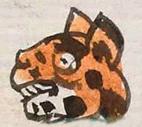tecuani (Mdz13v)
This element for a ferocious animal or wild beast (tecuani) has been carved from the compound sign for the place name, Tecuantepecc (today, Tehuantepec). It is a jaguar head in profile, looking toward the viewer's left. Its coat is orange with black spots. Its visible eye is open and teeth are visible in its mouth.
Stephanie Wood
Literally, tecuani refers to a people-eating creature. Fernando Horcasitas observed in contemporary Nahua communities that the dancers who played the role of the tecuani were dressed as jaguars. See ocelotl in our Online Nahuatl Dictionary.
c. 1541, but by 1553 at the latest
Stephanie Wood
“Tecuan” work of art by Marcela Guerrero Núñez on display in the Secretaría de Educación Pública, Mexico City. Photo by S. Wood, 7 May 2025.

tecuani, ferocious wild animal, literally one that bites people, https://nahuatl.wired-humanities.org/content/tecuani
cua, to eat or to bite, https://nahuatl.wired-humanities.org/content/cua
Bestia Feroz y Salvaje
Stephanie Wood
Codex Mendoza, folio 13 verso, https://digital.bodleian.ox.ac.uk/objects/2fea788e-2aa2-4f08-b6d9-648c00..., image 37 of 188.
The Bodleian Libraries, University of Oxford, hold the original manuscript, the MS. Arch. Selden. A. 1. This image is published here under the UK Creative Commons, “Attribution-NonCommercial-ShareAlike 3.0 License” (CC-BY-NC-SA 3.0).


